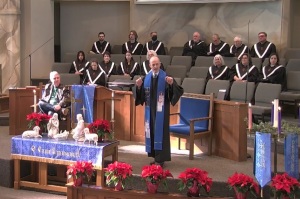Report: Mainline Protestant Churches Face Rockier Future
Mainline Protestant churches seem to have weathered the past decade better than many people have assumed, but the future is raising serious challenges to continued stability, said a Christian pollster.
George Barna analyzed data for The Barna Group's latest report examining mainline denominations. Weekend attendance at mainline churches has remained relatively stable, ranging from 89 to 100, over the past decade but the report suggests that they may be "on the precipice of a period of decline."
Mainline bodies – which the research group identifies as American Baptist Churches in the USA; The Episcopal Church; the Evangelical Lutheran Church in America; the Presbyterian Church (USA); the United Church of Christ; and the United Methodist Church – once dominated the Protestant landscape of America but today make up just one-fifth of all Protestant congregations today, the report notes.
Declining membership since the 1950s plus the growth among evangelical and Pentecostal churches have contributed to the shrinking of the mainline sector.
Only 15 percent of American adults identify with a mainline church, according to The Barna Group.
But even among congregants in mainline churches, the report points to a lack of commitment. Adherents are attending church services less frequently than they used to, volunteerism has dropped by 21 percent, and adult Sunday school involvement has decline by 17 percent since 1998.
Only 31 percent of mainline adults believe they have a personal responsibility to discuss their faith with people who have different beliefs and a minority of them are presently involved in some type of personal discipleship activity.
Many are also considering other spiritual options, the report states. Only 49 percent of mainline adults say they are "absolutely committed to Christianity;" less than half contend that the Bible is accurate in the life principles it teaches; more than half (51 percent) say they are willing to try a new church; and 67 percent are open to pursuing faith in environments or structures that are different from those of a typical church.
Additionally, 72 percent say they are more likely to develop own religious beliefs than to adopt those taught by their church and 86 percent sense that God is motivating people to stay connected to Him through different means and experiences than in the past.
Softly-held convictions are not the only things threatening the stability of mainline groups. The Ventura, Calif.-based research group predicts a rockier future as the percentage of adults attending mainline congregations who have children under the age of 18 living in their home has dropped (22 percent); the proportion of single adults has risen to 39 percent of all mainline adult attendees; and the number of divorced and widowed adherents has increased.
While weekend attendance has remained stable the report suggests that mainline churches have been attracting "just enough newcomers" to maintain their attendance levels and has not kept up with overall population growth in America.
Mainline churches are also not attracting many young people who are 25 or younger or minorities. Young adults make up only 2 percent of all adults attending mainline churches and Hispanics and Asians make up only 8 percent of mainline congregants.
The report draws attention to the significance of the failure to draw the growing Hispanic population. Moreover, many Hispanics are found to be leaving Catholicism and joining Protestant churches, but they're mostly settling into evangelical or Pentecostal Protestant congregations.
In other findings, pastors in mainline churches on average last only four years – about half the average among Protestant pastors in non-mainline churches – before moving to another congregation. The future of mainline churches hinges partly on the quality of leadership provided, Barna said.
The report is based on several national surveys among 267 mainline adults in 1998 and 1,148 adults in 2008. The surveys among pastors involved 492 mainline senior pastors.




























